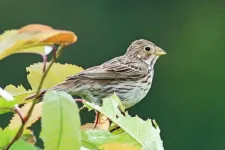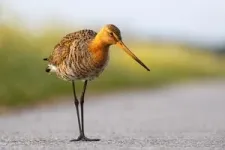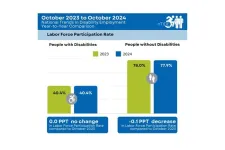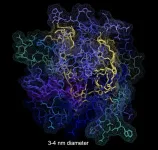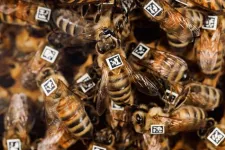(Press-News.org) Member states of the European Union are obliged to designate Special Protection Areas (SPAs) as part of the Natura 2000 network. These areas are designed to guarantee the preservation and restoration of bird populations. However, due to the paucity of data about rare species, it was not known how well these areas worked. Researchers at the University of Göttingen and Dachverband Deutscher Avifaunisten (DDA) developed citizen science platforms as a new data source to evaluate the effectiveness of the 742 protected areas for birds across Germany. This research shows that although these areas are well placed, their effectiveness varies greatly. When protected areas were compared with unprotected sites that showed similar geographical characteristics, only a few species thrived better inside the SPAs. The results were published in the journal Biological Conservation.
Citizen science platforms enable thousands of people to contribute to research with their observations – whether a single blackbird at a bird feeder or a long list of species seen during a day trip to the seashore. The study used the platform www.ornitho.de, which contains more than 90 million records. The advantage of such platforms is that they provide almost complete coverage of the country. However, the poorly standardised and unsystematic data collection process means that there are multiple sources of error. For this reason, the researchers limited their analysis just to particularly valuable, complete lists that provide information on all birds registered during an observation. To find out how the protected areas fared, the researchers compared them with areas that were not protected but had similar natural features.
The analyses showed that 62 per cent of the species studied were more likely to be found in a Special Protection Area than outside it. Dr Femke Pflüger, first author of the study, based at the DDA and Göttingen University’s Department of Conservation Biology, highlights these positive findings: “Conservationists obviously did a good job in selecting the right areas in the 2000s.” However, a comparison over time showed more mixed results and she adds: “For the period 2012 to 2022, we were only able to identify positive developments in protected areas for 17 per cent of the species. These concerned mainly meadow birds such as black-tailed godwits and curlews, which have benefited from targeted habitat management.” For 83 per cent of the species, there was either no measurable effect or the development was less favourable inside the protected areas than outside. The study also defined situations as ‘effective protection’ if the probability of finding a species decreased over time, both inside and outside the protected areas, but to a lesser extent within them.
Professor Johannes Kamp, Head of the Department of Conservation Biology at the University of Göttingen who led the analyses, says: “This shows that designating a Special Protection Area is not enough to stop a downward trend. The areas need better staffing and funding to restore habitats and to target measures specifically to support endangered species.” Dr Jakob Katzenberger, who coordinates the DDA's research, is delighted that thousands of citizens contributed: “We were able to show that collecting biodiversity data from online platforms has huge potential. It was possible to track large-scale changes in birdlife really effectively.”
This research was made possible thanks to funding by the German Federal Agency for Nature Conservation (BfN) as part of the project ‘Implementation of measures for nationwide harmonised bird monitoring in EU special protection areas’.
Original publication: Pflüger, F.J. et al: “Semi-structured citizen science data reveal mixed effectiveness of EU Special Protection Areas (SPA) in Germany.” Biological Conservation 2024. DOI: 10.1016/j.biocon.2024.110801
Contact:
Professor Johannes Kamp
University of Göttingen
Department of Conservation Biology
Bürgerstraße 50, 37073 Göttingen
Tel: +49 (0)551 39-25207
Email: johannes.kamp@uni-goettingen.de
www.uni-goettingen.de/conservation
Dr Femke Pflüger
Dachverband Deutscher Avifaunisten (DDA) and
University of Göttingen
Department of Conservation Biology
Bürgerstraße 50, 37073 Göttingen
Tel: +49 (0)551 39-25207
Email: fpflueg@gwdg.de
www.dda-web.de/dda/team/mitarbeiter/Pfl%C3%BCger,Femke
Member states of the European Union are obliged to designate Special Protection Areas (SPAs) as part of the Natura 2000 network. These areas are designed to guarantee the preservation and restoration of bird populations. However, due to the paucity of data about rare species, it was not known how well these areas worked. Researchers at the University of Göttingen and Dachverband Deutscher Avifaunisten (DDA) developed citizen science platforms as a new data source to evaluate the effectiveness of the 742 protected areas for birds across Germany. This research shows that although these areas are well placed, their effectiveness varies greatly. When protected areas were compared with unprotected sites that showed similar geographical characteristics, only a few species thrived better inside the SPAs. The results were published in the journal Biological Conservation.
Citizen science platforms enable thousands of people to contribute to research with their observations – whether a single blackbird at a bird feeder or a long list of species seen during a day trip to the seashore. The study used the platform www.ornitho.de, which contains more than 90 million records. The advantage of such platforms is that they provide almost complete coverage of the country. However, the poorly standardised and unsystematic data collection process means that there are multiple sources of error. For this reason, the researchers limited their analysis just to particularly valuable, complete lists that provide information on all birds registered during an observation. To find out how the protected areas fared, the researchers compared them with areas that were not protected but had similar natural features.
The analyses showed that 62 per cent of the species studied were more likely to be found in a Special Protection Area than outside it. Dr Femke Pflüger, first author of the study, based at the DDA and Göttingen University’s Department of Conservation Biology, highlights these positive findings: “Conservationists obviously did a good job in selecting the right areas in the 2000s.” However, a comparison over time showed more mixed results and she adds: “For the period 2012 to 2022, we were only able to identify positive developments in protected areas for 17 per cent of the species. These concerned mainly meadow birds such as black-tailed godwits and curlews, which have benefited from targeted habitat management.” For 83 per cent of the species, there was either no measurable effect or the development was less favourable inside the protected areas than outside. The study also defined situations as ‘effective protection’ if the probability of finding a species decreased over time, both inside and outside the protected areas, but to a lesser extent within them.
Professor Johannes Kamp, Head of the Department of Conservation Biology at the University of Göttingen who led the analyses, says: “This shows that designating a Special Protection Area is not enough to stop a downward trend. The areas need better staffing and funding to restore habitats and to target measures specifically to support endangered species.” Dr Jakob Katzenberger, who coordinates the DDA's research, is delighted that thousands of citizens contributed: “We were able to show that collecting biodiversity data from online platforms has huge potential. It was possible to track large-scale changes in birdlife really effectively.”
This research was made possible thanks to funding by the German Federal Agency for Nature Conservation (BfN) as part of the project ‘Implementation of measures for nationwide harmonised bird monitoring in EU special protection areas’.
Original publication: Pflüger, F.J. et al: “Semi-structured citizen science data reveal mixed effectiveness of EU Special Protection Areas (SPA) in Germany.” Biological Conservation 2024. DOI: 10.1016/j.biocon.2024.110801
Contact:
Professor Johannes Kamp
University of Göttingen
Department of Conservation Biology
Bürgerstraße 50, 37073 Göttingen
Tel: +49 (0)551 39-25207
Email: johannes.kamp@uni-goettingen.de
www.uni-goettingen.de/conservation
Dr Femke Pflüger
Dachverband Deutscher Avifaunisten (DDA) and
University of Göttingen
Department of Conservation Biology
Bürgerstraße 50, 37073 Göttingen
Tel: +49 (0)551 39-25207
Email: fpflueg@gwdg.de
www.dda-web.de/dda/team/mitarbeiter/Pfl%C3%BCger,Femke
END
More resources needed to protect birds in Germany
Citizen scientists enable Göttingen University researchers to analyse effectiveness of protected areas
2024-11-01
ELSE PRESS RELEASES FROM THIS DATE:
Mission to International Space Station launches research on brain organoids, heart muscle atrophy, and cold welding
2024-11-01
KENNEDY SPACE CENTER (FL), November 1, 2024 – More than 25 payloads sponsored by the International Space Station (ISSInternational Space Station) National Laboratory, including technology demonstrations, in-space manufacturing, student experiments, and multiple projects funded by the U.S. National Science Foundation (NSF), are bound for the orbiting outpost. These investigations, launching on SpaceX’s 31st Commercial Resupply Services (CRS) mission for NASANational Aeronautics and Space Administration, aim to improve life on Earth through space-based research and foster a sustainable economy in low Earth orbit(Abbreviation: ...
nTIDE November 2024 Jobs Report: Disability employment remains near historic highs over past 18 months
2024-11-01
East Hanover, NJ – November 1, 2024 – Following significant gains since the post-pandemic lockdown, employment rates for people with disabilities may have plateaued, remaining near historic high levels over the past 18 months despite the Federal Reserve’s efforts to slow the economy, according to today’s National Trends in Disability Employment – semi-monthly update (nTIDE) issued by Kessler Foundation and the University of New Hampshire’s Institute on Disability
Year-to-Year nTIDE Numbers (comparing October 2023 to October 2024)
The employment-to-population ratio for people with disabilities (ages 16-64) ...
Researchers aim to streamline cancer detection with new method for liquid biopsies
2024-11-01
A University of Rochester research team is reporting a new way to detect cancer cells with a “liquid biopsy” that’s designed to be simpler, faster, and more informational than current methods.
What is a liquid biopsy? It is a non-invasive test that uses blood, urine, and other bodily fluids as a vehicle for finding cancer cells or other molecules released by tumors. A liquid biopsy can detect or screen for cancer or monitor progression of the disease and how the body responds to cancer treatment.
James ...
New Huntington’s treatment prevents protein aggregation
2024-11-01
Scientists at Northwestern and Case Western Reserve universities have developed the first polymer-based therapeutic for Huntington’s disease, an incurable, debilitating illness that causes nerve cells to break down in the brain.
Patients with Huntington’s disease have a genetic mutation that triggers proteins to misfold and clump together in the brain. These clumps interfere with cell function and eventually lead to cell death. As the disease progresses, patients lose the ability to talk, walk, swallow and ...
Bee gene specifies collective behavior
2024-11-01
Embargoed: Not for Release Until 2:00 pm U.S. Eastern Time Friday, 01 November 2024.
Researchers at Heinrich Heine University Düsseldorf (HHU) are collaborating with colleagues from Frankfurt/Main, Oxford and Würzburg to investigate how the complex, cooperative behaviour of honey bees (Apis mellifera) is genetically programmed so that it can be passed on to subsequent generations. As they explain in the scientific journal Science Advances, they found an answer in what is known as the doublesex gene (dsx).
Behavioural interactions between organisms are fundamental and often inherited. ...
Jennifer Bickel, M.D., named MD Anderson Vice President and Chief Wellness Officer
2024-11-01
HOUSTON ― The University of Texas MD Anderson Cancer Center today announced the selection of Jennifer Bickel, M.D., as the institution’s inaugural vice president and chief wellness officer (CWO). She will begin on January 6, 2025. Working closely with the senior vice president of people, culture and infrastructure, as well as the chief academic officer, she will spearhead initiatives that prioritize employee well-being, professional fulfillment and community resilience.
In her new role, Bickel will implement a three-component model focusing on a culture of wellness, efficiency ...
Evolutionary paths vastly differ for birds, bats
2024-11-01
ITHACA, N.Y. – New Cornell University research has found that, unlike birds, the evolution of bats’ wings and legs is tightly coupled, which may have prevented them from filling as many ecological niches as birds.
“We initially expected to confirm that bat evolution is similar to that of birds, and that their wings and legs evolve independently of one another. The fact we found the opposite was greatly surprising,” said Andrew Orkney, postdoctoral researcher in the laboratory of Brandon Hedrick, assistant professor biomedical sciences.
Both researchers ...
Political pros no better than public in predicting which messages persuade
2024-11-01
Political campaigns spend big bucks hiring consultants to craft persuasive messaging, but a new study coauthored by Yale political scientist Joshua L. Kalla demonstrates that political professionals perform no better than laypeople in predicting which messages will sway voters.
In the study, Kalla and his coauthors evaluated how well sample groups of political practitioners — professionals who work for political campaigns, polling firms, and advocacy organizations — and members of the public could predict the effectiveness of 172 campaign messages concerning 21 political issues, including legalizing marijuana, cancelling student debt, and increasing ...
Investment in pediatric emergency care could save more than 2,100 young lives annually
2024-11-01
In emergencies, children have distinct needs because of their unique physiological, emotional and developmental characteristics. But 83% of emergency departments nationwide are not fully prepared to meet those needs — which can be life-threatening for a child in cases of severe illness or injury.
A new Oregon Health & Science University-led study, published today in JAMA Network Open, found that bridging that gap, known as becoming “pediatric ready,” could prevent the deaths of more than 2,100 children each year with modest financial investment. ...
The dynamic core of black holes
2024-11-01
Black holes continue to captivate scientists: they are purely gravitational objects, remarkably simple, yet capable of hiding mysteries that challenge our understanding of natural laws. Most observations thus far have focused on their external characteristics and surrounding environment, leaving their internal nature largely unexplored. A new study, conducted through a collaboration between the University of Southern Denmark, Charles University in Prague, Scuola Internazionale Superiore di Studi Avanzati (SISSA) in Trieste, and Victoria University of Wellington ...
LAST 30 PRESS RELEASES:
First Editorial of 2026: Resisting AI slop
Joint ground- and space-based observations reveal Saturn-mass rogue planet
Inheritable genetic variant offers protection against blood cancer risk and progression
Pigs settled Pacific islands alongside early human voyagers
A Coral reef’s daily pulse reshapes microbes in surrounding waters
EAST Tokamak experiments exceed plasma density limit, offering new approach to fusion ignition
Groundbreaking discovery reveals Africa’s oldest cremation pyre and complex ritual practices
First breathing ‘lung-on-chip’ developed using genetically identical cells
How people moved pigs across the Pacific
Interaction of climate change and human activity and its impact on plant diversity in Qinghai-Tibet plateau
From addressing uncertainty to national strategy: an interpretation of Professor Lim Siong Guan’s views
Clinical trials on AI language model use in digestive healthcare
Scientists improve robotic visual–inertial trajectory localization accuracy using cross-modal interaction and selection techniques
Correlation between cancer cachexia and immune-related adverse events in HCC
Human adipose tissue: a new source for functional organoids
Metro lines double as freight highways during off-peak hours, Beijing study shows
Biomedical functions and applications of nanomaterials in tumor diagnosis and treatment: perspectives from ophthalmic oncology
3D imaging unveils how passivation improves perovskite solar cell performance
Enriching framework Al sites in 8-membered rings of Cu-SSZ-39 zeolite to enhance low-temperature ammonia selective catalytic reduction performance
AI-powered RNA drug development: a new frontier in therapeutics
Decoupling the HOR enhancement on PtRu: Dynamically matching interfacial water to reaction coordinates
Sulfur isn’t poisonous when it synergistically acts with phosphine in olefins hydroformylation
URI researchers uncover molecular mechanisms behind speciation in corals
Chitin based carbon aerogel offers a cleaner way to store thermal energy
Tracing hidden sources of nitrate pollution in rapidly changing rural urban landscapes
Viruses on plastic pollution may quietly accelerate the spread of antibiotic resistance
Three UH Rainbow Babies & Children’s faculty elected to prestigious American Pediatric Society
Tunnel resilience models unveiled to aid post-earthquake recovery
Satellite communication systems: the future of 5G/6G connectivity
Space computing power networks: a new frontier for satellite technologies
[Press-News.org] More resources needed to protect birds in GermanyCitizen scientists enable Göttingen University researchers to analyse effectiveness of protected areas
